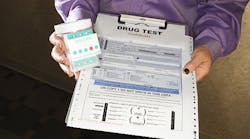The Occupational Safety and Health Administration (OSHA) has delayed enforcement of its new injury and illness record-keeping rule to Dec. 1 to try to clear up confusion it created over post-accident drug testing of employees. It also remains possible that court challenges mounted by employer groups could block the rules’ implementation before that day rolls around.
Under the rules adopted earlier this year companies in covered industries with more than 250 employees are required to submit their annual injury and illness Forms 300, 300A and 301 electronically. Those electronically-filed reports also will be made public on the Internet for anyone to see—including tort lawyers and labor organizers.
Employers also were confused because of the final rules’ provision offering protection against retaliation by employers against employees who report injuries. In doing so, OSHA appeared to ban post-accident drug testing under the reasoning that it could be used to intimidate employees into not filing reports.
In its latest guidance the agency clarifies that it won’t issue citations for drug testing mandated by federal or state laws (such as Department of Transportation truck driver testing), or testing required by state workers’ compensation laws.
OSHA also says that employers are not prohibited from drug testing employees “who report work-related injuries or illnesses so long as they have an objectively reasonable basis for testing, and the rule does not apply to drug testing employees for reasons other than injury-reporting.”
“This is good news for employers who conduct drug and alcohol testing required by federal law, or in accordance with state laws, including state workers’ compensation premium reduction laws,” says attorney Kathryn J. Russo of the law firm of Jackson Lewis.
However, attorney Howard A. Mavity of the Fisher Phillips law firm warns that “the actual rule language is brief and neither as expansive or detailed as OSHA’s interpretations suggest.”
OSHA says “employers must establish a reasonable procedure for employees to report work-related injuries and illnesses promptly and accurately. A procedure is not reasonable if it would deter or discourage a reasonable employee from accurately reporting a workplace injury or illness.”
The agency adds, “To strike the appropriate balance here, drug testing policies should limit post-incident testing to situations in which employee drug use is likely to have contributed to the incident, and for which the drug test can accurately identify impairment caused by drug use.”
How to Protect Yourself
How to establish and run a post-injury drug testing program that will pass OSHA scrutiny requires careful attention to the factors the agency says it will consider to determine if it is acceptable or a violation deserving a citation. These include evaluating whether:
• The employer had a reasonable basis for concluding that drug use could have contributed to the injury or illness, and as a result of the drug test could provide insight into why the injury or illness occurred.
• Other employees involved in the incident that caused the injury or illness also were tested.
• The employer only tested the employee who reported the injury or illness.
• The employer has a heightened interest in determining if drug use could have contributed to the injury or illness due to the hazardousness of the work being performed when the injury or illness occurred.
To protect yourself, Mavity says an employer should first determine if automatic post-accident drug testing is worth the effort. Some employers have reviewed years of results and determined that automatic post-accident testing is not needed at their operation, he notes.
But other employers who saw positive drug tests decrease for the previous 16 years experienced a spike in 2014-15. “These employers have concluded that drug testing is increasingly important, especially for abused pain medications and ‘black tar’ heroin,” he points out.
A recent nationwide study found positive drug tests of employees have risen steadily between 2011 and 2015. The Quest Diagnostics survey of workplace drug test results examined nearly 11 million workplace drug test results in 2015 and found that positive results made up 4% of the total, and about 9% of job applicants could not pass a pre-employment hair drug test.
Post-accident positive test results rates increased 30% since 2011, Quest found. The rate of amphetamine, marijuana and heroin detection has increased every year for the past five years, and positive test results for heroin soared 146%.
Mavity say you also should check if your state has a Drug Free Workplace Program law, which typically is included as part of state workers’ compensation laws. Usually voluntary, if an employer participates in such a program it could reduce possible workers’ comp penalties and offer other benefits, and some of these programs require participating employers to pursue automatic post-accident drug testing.
In addition, he says you can adopt additional factors that would trigger an automatic drug test, such as a certain estimated amount of property damage. Also, consider limiting testing to those employees who caused the incidents, Mavity suggests.
For example, he says, if the operator of a forklift struck another employee, only test the operator instead of mandating testing for all employees involved, including the employee who was injured by the forklift.




